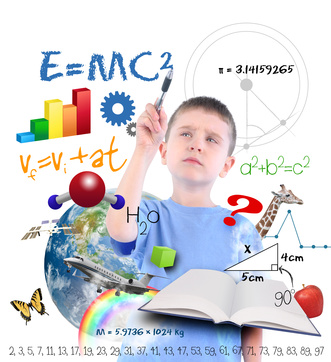Even Numbers Have Words! Is your child struggling with math? Work on their language skills.
Is your child struggling with math? Work on their language skills.
Tom has five apples and Sayid gives him two more. Later that day, Tom’s sister Jenny eats three of his apples. How many apples does Tom have left?
Do you have your answer? If you said four, you’re correct.
Now, what if I asked you to explain how you were able to solve the word problem above? It goes beyond simply knowing how to add and subtract – after all, the words “add” and “subtract” never appear.
To figure out how many apples Tom has, you need to call on a specific skill.
This skill, of course, is language.
The Language of Mathematics
We often think of math as the realm of numbers, but math is built from language. In fact, several studies have shown that language and math skills are closely linked. The solution to becoming better at math? Become better at language.
Of course, math also has its own special vocabulary. The language of mathematics takes many forms, from the numbers themselves (which are simply words with an understood value) to the characteristics we assign those numbers.
This is why rote memorization is not effective by itself. Instead, your young critical thinker should become fluent in the vocabulary of math. As they learn to speak the language they are able to think critically about the problems they are presented with (including those pesky word problems).
Language Adds Context
Math doesn’t (and shouldn’t) take place in a vacuum. There is no point in becoming skilled at math if it can’t be applied to the real world.
For example, if you tell a child they have “five”, what is their most likely response?
“Five what?”
Even a young child understands that “five” can’t stand alone. It’s an abstract concept. To be made concrete the number “five” must be followed by a word.
For example, saying “Tom has five apples” carries a lot more meaning than saying “Tom has five”.
These units of measurement help students form a mental picture. Five years looks a lot different than five minutes. Five degrees Celsius is not the same thing as five degrees Fahrenheit. Five inches and five feet paint very different images in a child’s head.
The Language of Math Helps Define Relationships
Geometry is filled with new vocabulary, from two-dimensional shapes (square, rhombus, rectangle, triangle) to three-dimensional shapes (sphere, cylinder, pyramid) to measurements (diameter, area, perimeter, circumference, angle).
If a child doesn’t understand the basic difference between the word “sphere” and the word “circle” the topic becomes much more difficult.
This same language also helps young learners understand the relationships between numbers and objects. Words such as “greater than” and “less than” allow students to create comparisons between shapes and numbers.
Math Builds Inferencing Skills
Let’s look back at Tom and his apples.
While you were never explicitly told to add five and two, you knew that’s what you needed to do. The language of the question led you to this conclusion. Similarly, when Jenny ate three apples you understood that Tom lost them, so they should be subtracted from the total.
Certain words and phrases, such as “gives him” and “eats” allow us to infer whether what sort of math to use. By themselves, these aren’t math terms. When placed in the context of a word problem, they give young learners key information.
Inferencing is a critical thinking skill that carries over into all walks of life. Developing strong inferencing skills helps children interact with their world and understand it on a deeper level.
The secret to understanding math? Understanding language.
If you have a child who is struggling with math concepts, it’s worth examining his or her understanding of language. Can they identify the context surrounding numbers, shapes, and lines? Are they able to make inferences based on word problems?
Words are everywhere, and math is no exception. Linking the two together in harmony will help your child succeed in math and in everyday life.




I loved the point you made about how there’s no point in becoming skilled at math if it can be applied to the real world. I’ve heard that learning becomes much easier when you can connect or relate to the concept. It sounds like this applies to math as well.
Absolutely! So often students struggle with math because they’re trying to learn it in isolation. Without real-world context, it makes no sense. Thank you for commenting!
Thanks for sharing your thoughts. I truly appreciate your efforts and I will
be waiting for your further write ups thank you
once again.